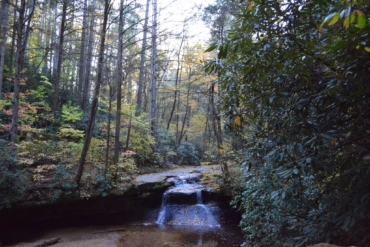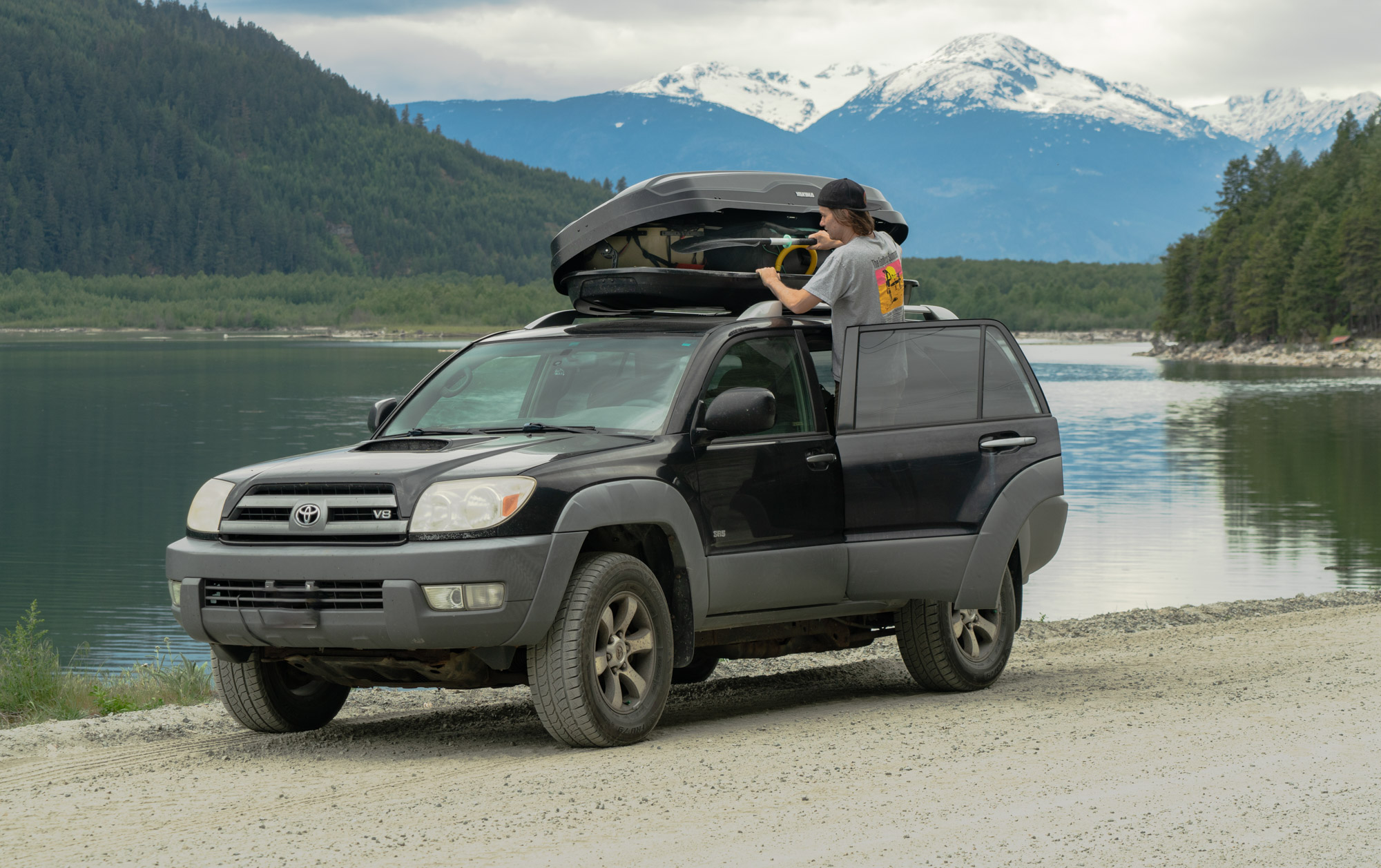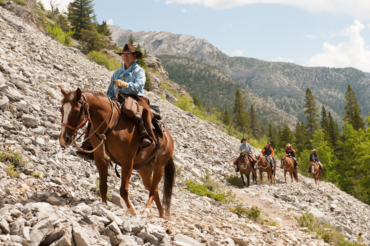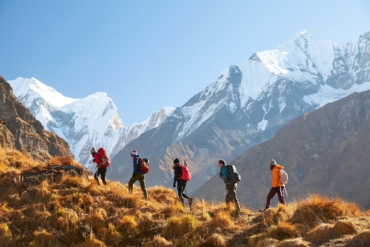Top photo: Kiteboarding in Boracay, Phillippines; photo by Anastasia Zhebyuk
Where should you plan your next kiteboarding trip? We’ve got you covered with the best kiteboarding locations for your next vacation.
If you’ve noticed yourself zoning out at work lately or spending all your time scrolling through WindAlert while fantasizing about a salty beach somewhere, it may be time to get out of town. Whether the wind has dried up in your neck of the woods or you’re simply itching for a tropical vacation, an exotic kiteboarding trip can be the perfect way to reset your kiting chi.
Fortunately, the globe is covered in amazing kitesurfing spots that offer consistent wind throughout the year, along with sunny beaches and gorgeous sunsets. To help you plan the perfect kiting vacation, we’ve put together a list of the best locations worldwide so you can get started on your next adventure.
Best Kiteboarding in Europe
Tarifa, Spain

With white-sand beaches and a remarkable 300-plus windy days per year, Tarifa has long been dubbed the kitesurfing capital of Europe. Composed of a series of kiting beaches that stretch for more than 6 miles along the southern tip of Spain’s Costa de la Luz, the destination claims some of the most consistently windy, kite-able days of anywhere on the planet. The town itself is full of charming cobbled streets and Spanish flair overlooking the Strait of Gibralter.
There are two types of winds that blow at Tarifa: Poniente, which comes in from the west, and Levante, which blows from the east. Poniente is a cross-onshore wind and is by far the better, more consistent wind of the two. The conditions make it more beginner-friendly (although intermediate and advanced riders will find plenty to love too). Levante, by contrast, is much stronger and gustier, blowing offshore and cross-offshore. If you’re considering going out in Levante, you’ll need to purchase rescue boat tokens — if they have to come and get you without tokens, it will cost $150.
Tarifa Quick Stats
- Windy season: Apr to Oct (peak Jun to Aug)
- Wind speed: Poniente: 10 to 30 mph; Levante: 20 to 45 mph
- Wind direction: Poniente: cross-onshore; Levante: offshore/cross-offshore
- Air temperature: 77 to 86 degrees F
- Water temperature: 68 degrees F
- Rider level: Beginner to advanced
- Attractions: Scuba diving, standup paddleboarding, mountain biking, surfing, horseback riding, castles, ruins, migrating birds, whale watching, Mediterranean food, nightlife
- Hazards: Rocks
Leucate, France
Every year, the French seaside village of Leucate hosts the Mondial Du Vent. The big event occurs in April when gusts are the strongest, but you can find fantastic, consistent wind throughout the year. The town is situated on the northern tip of the Étang de Leucate lagoon. During the summer months, the beach offers a dedicated kite zone with a free campground, cozy beach bars, and a handful of kite schools.
When you’re not kiting, you can climb the hillside to the lighthouse on Cap Leucate to catch a stunning view of the Mediterranean Sea all the way to the Spanish border. The town is famous for oysters (watch the oyster beds in the lagoon), and during the evenings, tourists flock to its quaint outdoor bistros.
The main wind in Leucate is the Tramontane which blows in from the northwest carrying very strong offshore winds. This wind is best for more advanced riders, bringing exceptional freestyle conditions. The Marin offers lighter, more beginner-friendly winds that come in cross-onshore from the southeast (though they sometimes can bring waves up to 6 feet).
Leucate Quick Stats
- Windy season: Year-round; best Jul to Oct (summer) and Mar to Apr (winter)
- Wind speed: Tramontane: 17 to 31 mph (up to 46 mph in winter); Marin: lighter
- Wind direction: Tramontane: offshore (boat rescue); Marin: cross-onshore
- Air temperature: 77 to 81 degrees F (summer); 58 to 64 degrees F (winter)
- Water temperature: 70 to 77 degrees F (summer); 51 to 53 degrees F (winter)
- Rider level: Beginner to advanced
- Attractions: Jet skiing, scuba diving, sand yachting, standup paddleboarding, wakeboarding, fishing, canoeing, horseback riding, tennis, paragliding, whitewater rafting, golfing, biking, aquatic park, nature walks
- Hazards: Oyster beds
North American Kiteboarding Spots
Columbia River Gorge, United States

Tucked in a picturesque, rocky river canyon, the Columbia River Gorge is a scenic area in the Pacific Northwest filled with leafy evergreen forests and cascading waterfalls. In the summertime, it morphs into a veritable kitesurfing mecca, drawing wind enthusiasts from all over the globe to the town of Hood River, Oregon. The outdoorsy tourist town is known for microbreweries, wineries, and fresh fruit stands. The Columbia River, which divides Oregon and Washington, features a series of kiting beaches on both sides, as well as a sandbar with a dedicated kite launch.
The wind comes in via giant basalt cliffs on either side of the water that work together to act as a natural wind funnel, ushering in coastal breezes and blowing them through the canyon. The wind is strong and consistent with Hood River’s launch sites receiving westerlies most days from June to August. West of town, beaches farther down the highway get eastern winds on occasion as well. Wind in the Gorge tends to be gusty and punchy, which makes it tough for beginners. However, the direction is mostly side-shore, so it’s forgiving and there are plenty of kite schools eager to show new kiters the ropes.
Columbia River Gorge Quick Stats
- Windy season: May to Sep (peak: late Jun to Aug)
- Wind speed: 12 to 35 mph, strong gusts
- Wind direction: Side-shore
- Air temperature: 72 to 88 degrees F
- Water temperature: 52 to 72 degrees F
- Rider level: Beginner to advanced
- Attractions: Standup paddleboarding, recreational kayaking, whitewater kayaking, mountain biking, hiking, wine tasting, microbreweries, restaurants, historical museums, art centers, mellow nightlife
- Hazards: Rocks, barges
La Ventana, Mexico

Sometimes called the “Tarifa of Mexico,” La Ventana was once a sleepy Mexican fishing village that’s been gaining notoriety in recent years as a kitesurfing hotspot. The town is situated on the Sea of Cortez on the eastern coast of the Baja Peninsula. During the high season (December to March), it fills with campervans as kiters from the U.S. drive their RVs across the border to set up seasonal campsites along the beach. The town is surrounded by cactus-filled desert with mountain ranges in the distance. Inside the village, you’ll find locals and expats drinking Tecates and eating ceviche, along with their oddly famous hotdog stands.
The kiting beach runs from the town of El Sargento, about 2.5 miles north, to La Ventana, offering wide open beaches with pristine white sands. It’s a fantastic spot for beginners due to its “L” shape, jutting out into the ocean and providing what locals call the Catcher’s Mitt. You can take long, lazy downwinders, and the lowermost beach will catch you at the bottom. The steady thermals blow from about 12 p.m. to 5:30 p.m. almost every day, bringing moderate wind that occasionally punches up when a northern cold front comes through.
La Ventana Quick Stats
- Windy season: Late Nov to Mar
- Wind speed: Thermals: 17 to 28 mph; northern: up to 35 mph
- Wind direction: Side-shore
- Air temperature: 72 to 88 degrees F
- Water temperature: 70 to 75 degrees F
- Rider level: Beginner to advanced
- Attractions: Kayaking, scuba diving, snorkeling, standup paddleboarding, spearfishing, mountain biking, whale watching, hiking, farmer’s markets, yoga
- Hazards: Reefs north of town
South America and the Caribbean
Cabarete, Dominican Republic

One of the premiere kiting destinations of the Caribbean, Cabarete is known worldwide for its windy beaches and vibrant party scene. Located on the northern shore of the Dominican Republic, the kite beach itself boasts a stunning coastline with a navy-blue lagoon and towering green hills in the background. It’s dotted with lazy palm trees arching in the heat as well as a series of small restaurants and kite schools. In town, it’s typically full of laid-back locals sipping Presidentes or dancing at the nightclubs, which stay open into the wee hours of the morning.
As far as the wind goes, there is an offshore reef that works with the hills to create a thermal effect — when the tradewinds roll in, they typically blow cross-onshore. The beach stretches about 2.5 miles, and the wind usually starts blowing around 4 p.m. The water is warm and the wind is consistent (the area gets 200-plus windy days per year), the best of which blows from April through September.
Cabarete Quick Stats
- Windy season: Apr to Sep
- Wind speed: 16 to 27 mph (Jan to Apr); 18 to 35 mph (May to Aug); 10 to 23 mph (Sep to Dec)
- Wind direction: Cross-onshore
- Air temperature: 80 to 86 degrees F
- Water temperature: 78 to 81 degrees F
- Rider level: Beginner to advanced
- Attractions: Snorkeling, surfing, standup paddleboarding, ziplining, canyoning, mountain biking, horseback riding, caving, golf, national parks, restaurants, nightlife
- Hazards: Reefs
Cumbuco, Brazil
By far the best-known kiting destination in Brazil, Cumbuco is a tiny fishing village on the northern coast. It’s become a huge magnet for kitesurfers over the years as the sport has grown in popularity. It’s a common training ground for many of the world’s pros, and in the evenings you’ll often see hordes of wind enthusiasts sipping caipirinhas around bonfires or mingling in the beachside bars.
Cumbuco is the most popular beach, but the coast features kiting villages scattered along its shores for 60 miles. If you want to check out some of the others, start at Cumbuco and make your way north through spots like Uruau, Macapa, Jericoacoara, Paracuru, Lagoinha, Guajiru, Barra Grande, and others. There’s humble lodging in kite pousadas along the way that offer simple bed-and-breakfast-style accommodations for your kite safari. If you have a hankering for a wild party, Fortaleza lies 40 minutes in the other direction.
From June to February, strong tradewinds blow almost every day. They arrive in a cross or cross-onshore direction from the right, sending their strong breezes along a golden-sand beach that sprawls out for nearly 4 miles. The long length of the beach allows riders to spread out more, so the launch sites aren’t as crowded as many similar destinations. That said, there are often horses and cars on the beach, so be mindful when launching and landing. If you’re seeking a downwinder, you can start at the southeastern end of the beach and ride all the way to Cauipe Lagoon, where there are usually buggies available to catch back up. There are also lots of guided downwinders in the region that host trips along the coast.
Cumbuco Quick Stats
- Windy season: Jun to Feb (peak: Aug to Jan)
- Wind speed: Varies
- Wind direction: Sideshore
- Air temperature: 84 degrees F
- Water temperature: 80 degrees F
- Rider level: Beginner to advanced
- Attractions: Surfing, sailing, jet skiing, sandboarding, buggy rides, horseback riding, rafting
- Hazards: Cars on the beach, horses, swimmers, ships
Kiteboarding in Africa and the Middle East
Le Morne, Mauritius
Le Morne is one of the world’s higher-end kiting destinations. Nestled in a lagoon on the southwestern edge of the island of Mauritius, it’s just east of Mozambique and Madagascar. The popular tropical honeymoon destination is sprinkled with gorgeous crystal-blue lagoons and ivory-sand beaches. The town itself is mellow and quiet, though nightlife can be found about 20 miles north in the town of Flic en Flac. The area showcases a unique multicultural flair, and the food is a cool blend of Indian, Creole, and Chinese influences. Le Morne has a number of luxury hotels, so it definitely won’t be a budget kite vacation. However, there are ways to do it more affordably, namely by staying in La Gaulette, a small village 3 miles north.
The wind isn’t as quite consistent in Le Morne as it is in some places. But when it does blow, it’s some of the best in the world, particularly for intermediate and advanced riders. Like Cabarete, a large offshore reef protects the water and makes it smooth and flat near shore. Tradewinds arrive cross-shore from the left, offering three main waves: Small Reef closer in (for intermediate riders) and Manawa and One Eye farther out (for experts). Kiting season is during Mauritius’ winter, so temperatures are a bit lower; however, it’s windy more than 60 percent of the time from June through November.
Le Morne Quick Stats
- Windy season: Jun to Nov
- Wind speed: 18 to 30 mph
- Wind direction: Cross-shore
- Air temperature: 68 to 78 degrees F (during high season)
- Water temperature: 71 to 77 degrees F
- Rider level: Intermediate, advanced
- Attractions: Snorkeling, surfing, standup paddleboarding, ziplining, canyoning, mountain biking, horseback riding, caving, golf, national parks, restaurants, nightlife
- Hazards: Shells, trees, sharks, and strong currents in channels
El Gouna, Egypt
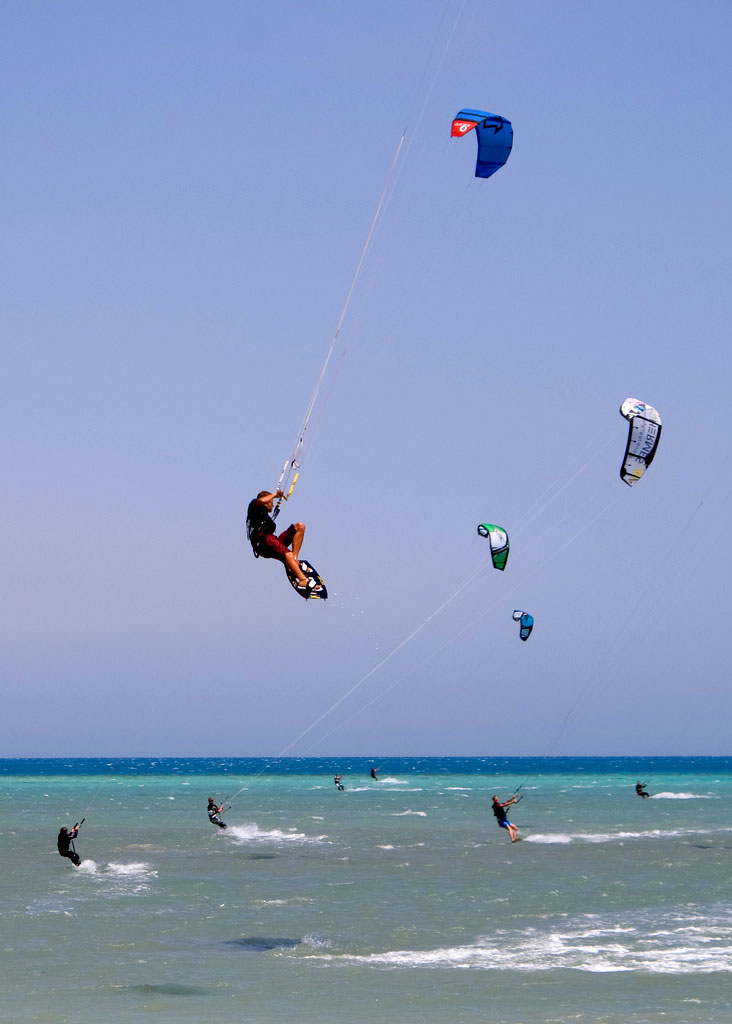
Widely considered the top kitesurfing spot in the Red Sea, El Gouna is a small resort on the eastern coast of Egypt, 20 miles north of the city of Hurghada. The cluster of small islands and lagoons offers aqua-blue water, white-sand beaches, and tons of swanky food and nightlife.
The sunny coastal spot features steady, consistent wind and a wide open beach, making it an excellent spot for beginners. The resort, which has been called the “French Riviera of the Red Sea” and “Egyptian Disneyland,” is typically full of tourists and yacht owners smoking shisha and basking in the sun. Like Le Morne, El Gouna caters to the luxury traveler. Accommodations will be pricier, but you can find a few budget options scattered throughout if you dig around.
The wind blows year-round in El Gouna; even during the low season (November through February), there’s a 60 percent chance of wind. It comes in from the north either cross-shore or cross-onshore depending on which of the two beaches you head to. The first option is a stretch of water between Mangroovy and Buzzha beaches where it’s shallow far out into the water, making it a great beginner’s spot. To the south is the five-star Moevenpick hotel, which has a private beach that non-guest kitesurfers can pay a day rate to launch from. Both beaches can be accessed from town via an easy tuk-tuk ride.
El Gouna Quick Stats
- Windy season: Year-round (peak: Apr to Oct)
- Wind speed: 13 to 31 mph
- Wind direction: Cross-shore, cross-onshore
- Air temperature: 73 to 104 degrees F
- Water temperature: 75 to 78 degrees F
- Rider level: Beginner to advanced
- Attractions: Sailing, scuba diving, snorkeling, standup paddleboarding, kayaking, parasailing, jet skiing, golfing, paintball
- Hazards: Coral reefs, bystanders
Asia Kiteboarding
Mui Ne, Vietnam
On the southern coast of Vietnam, four hours east of Ho Chi Minh, you’ll find Mui Ne — one of Southeast Asia’s biggest kiteboarding hotspots. With an average of 227 windy days per year, the sea breezes are strong and the local culture is charming (and affordable). Mui Ne is a laid-back fishing village with temples scattered around the outskirts. Down on the beach, you’ll spot stunning sand dunes, kite schools, and watering holes lining the blue water. When you’re not out riding, you can enjoy the region’s beautiful hiking trails or local dining staples like soup, fish, and noodles.
Mui Ne has two windy seasons. The first is the winter monsoon season when northeastern winds are extra gusty, blowing strong and fast all day. The other is the summer season when southwestern wind arrives in the afternoon most days, blowing much lighter wind. The kiting beach stretches about 9 miles from Mui Ne up to Phan Tiet. You can find a great spot for beginners on the main beach. And when the swell is up, more advanced riders can take advantage of the killer shore break.
Mui Ne Quick Stats
- Windy season: May to Oct (summer); Nov to Mar (winter/peak)
- Wind speed: 10 to 16 mph (summer); 10 to 35 (winter)
- Wind direction: On-shore, cross on-shore
- Air temperature: 77 to 86 degrees F
- Water temperature: 68 to 77 degrees F
- Rider level: Beginner to advanced
- Attractions: Surfing, standup paddleboarding, kayaking, jet-skiing, fishing, golf, cultural attractions
- Hazards: Bystanders
Boracay, Philippines

Another fantastic kiting spot in Asia is Boracay, a town situated on a tiny island in the central part of the Philippines. The picturesque spot boasts a sapphire-blue lagoon and 2.4 miles of stunning white-sand coastline. With amazing seafood and awe-inspiring sunsets, the town draws tons of tourists even without the wind. It has historically been a huge party town, but the island was shut down in 2018 for environmental rehabilitation. And officials tamed the party scene after its reopening in October 2018, including limiting alcohol on certain beaches.
The kite launch is on Bulabog Beach where there are two winds: the Amihan north wind, which comes in steadily from October through April, and the less consistent Habagat south wind from July through October. The water is often choppy with small waves out by the reef. There are some sea urchins on the ocean floor, so beginners are advised to wear protective booties.
Boracay Quick Stats
- Windy season: Oct to Apr (peak: Dec to Feb)
- Wind speed: 7 to 35 mph
- Wind direction: On-shore, cross on-shore
- Air temperature: 82 to 88 degrees F
- Water temperature: 80 degrees F
- Rider level: Beginner to advanced
- Attractions: Surfing, scuba diving, snorkeling, sailing, wakeboarding, golfing, mountain biking, zorbing, ziplining
- Hazards: Sea urchins, reefs, trees

